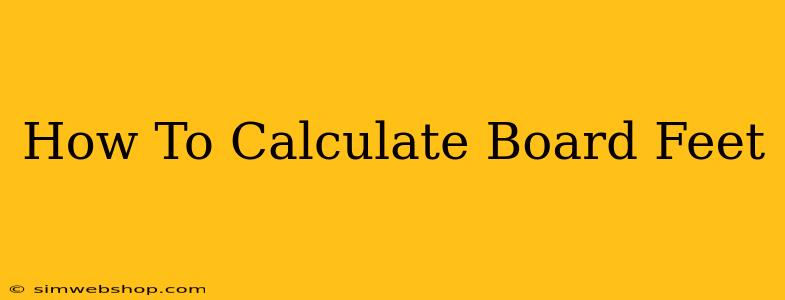Understanding board feet is crucial for anyone working with lumber, whether you're a seasoned carpenter or a DIY enthusiast. Accurately calculating board feet ensures you purchase the right amount of lumber for your project, avoiding costly waste or shortages. This comprehensive guide will walk you through the process, explaining the formula and offering practical examples.
What is a Board Foot?
A board foot (fbm) is a unit of lumber measurement representing a volume of wood equal to a board that is 1 foot long, 1 foot wide, and 1 inch thick. It's a standard unit used in the lumber industry to determine the quantity and cost of wood. It's important to note that board feet measure volume, not just surface area.
The Formula for Calculating Board Feet
The basic formula for calculating board feet is remarkably simple:
Board Feet = (Thickness in inches) x (Width in inches) x (Length in feet) / 12
Let's break down each component:
- Thickness: Measure the thickness of the board in inches.
- Width: Measure the width of the board in inches.
- Length: Measure the length of the board in feet. Make sure you are using feet, not inches!
Practical Examples: Calculating Board Feet
Let's illustrate the calculation with some practical examples:
Example 1: A standard 2x4
A common 2x4 is actually closer to 1.5 inches thick and 3.5 inches wide. Let's calculate the board feet for an 8-foot long 2x4:
Board Feet = (1.5 inches) x (3.5 inches) x (8 feet) / 12 = 3.5 board feet
Example 2: A thicker board
Let's calculate the board feet for a board that is 2 inches thick, 6 inches wide, and 10 feet long:
Board Feet = (2 inches) x (6 inches) x (10 feet) / 12 = 10 board feet
Example 3: Dealing with fractional measurements
What about a board with fractional measurements? Let's say you have a board that is 1.75 inches thick, 5.25 inches wide, and 6 feet long.
Board Feet = (1.75 inches) x (5.25 inches) x (6 feet) / 12 = 4.59 board feet (Round up to 4.6 board feet for practical purposes)
Tips for Accurate Measurement
- Use a reliable measuring tape: Accuracy is key. Use a tape measure that provides precise measurements.
- Measure in the correct units: Pay close attention to whether you are measuring in inches or feet. Using incorrect units will drastically affect your results.
- Account for imperfections: If the wood has any significant imperfections, you might need to adjust your calculations.
- Always round up: When dealing with fractional measurements, it's always better to round up to the nearest tenth of a board foot to ensure you have enough lumber.
Beyond the Basics: Calculating Board Feet for Irregular Shapes
The formula above works best for rectangular boards. Calculating board feet for irregularly shaped lumber requires more advanced techniques, often involving breaking down the shape into smaller, manageable rectangular sections and calculating the board feet for each section individually. For complex shapes, consider consulting a lumber professional.
Conclusion: Mastering Board Foot Calculation
Mastering board foot calculation is a valuable skill for anyone working with wood. By understanding the formula and following the tips provided in this guide, you can accurately estimate your lumber needs, ensuring your project is a success. Remember to always measure carefully and round up when necessary!

